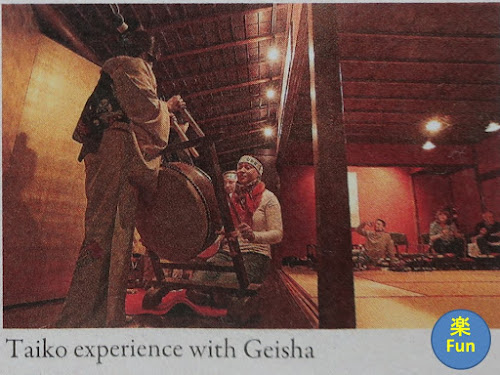There are three teahouse districts in Kanazawa even now. Kaikaro is located in Higashi(east) teahouse district which is the largest and the highest-status one. Teahouse is an entertainment establishment where people invite Geisha girls and have a party. Kaikaro is the largest teahouse here which was built in 1820. It is open to the public during day time, and sometimes there are parties in the evening.
Here is an old Japanese entertainment district, so it is also a
popular tourist attraction. There were many tourists when I visited, even
though it was rainy early evening.
 |
| Higashi teahouse district (Main street)、ひがし茶屋街 |
 |
| Alley of this district、裏通り |
金沢には、今も三つの茶屋街が残っているが、懐華楼があるひがし茶屋街は最も規模が大きく、格式がある茶屋街だ。私が訪れたときは小雨の午後だったが、通りには多くの観光客がいた。茶屋は芸者さんを呼んで、酒を飲み、遊ぶところ。この茶屋街で最も広いのが懐華楼で、今も茶屋として使われているが、昼は一般公開されており見学できる(訪問時の入場料は¥750)。1820年に建てられた。
Kaikaro is a three-story wooden building. There are only two guest rooms in Kaikaro which are in the 2nd floor. The entrance and living space are in the 1st floor, and the 3rd floor is for Geisha girls.
 |
Plain figure of 1st and 2nd
floor from its brochure
1階と2階の平面図、パンフレットから
|
一階は玄関と生活スペース、二階が芸者さんと遊ぶお座敷が二間だけ、三階が芸者さんの生活スペースだったそうだ。
Inside Kaikaro、懐華楼内部
At the entrance, there is a wide ladder (【1】in the plain figure above), which is coated by Wajima-lacquer. It boosts our mood. The ladder is wide enough for a customer and a Geisha to walk side by side.玄関には、輪島塗の赤い幅広の階段がある(平面図の【1】)。遊びに来た気になる。芸者さんとお客さんが一緒に降りられるように幅を広くしてあるという。
On the 2nd floor, there are guest rooms. “Shu-no-ma”, which means “vermilion (similar to red color) room”, is in front of the stair case. The wall and the edges of tatami mats are vermilion; merchants use the color usually. The color also shows up the beauty of Geisha girls as a background. Customers sit in front of the Toko-no-ma, and girls perform at the opposite side.
 |
| “Shu-no-ma”、朱の間 |
 |
| Geisha performance、懐華楼リーフレットから |
二階には、お座敷とその間にスペースとして一間設けている。階段を上がったところは、朱の間で壁も畳の縁も赤い。説明の方は紅柄と言っていたが、朱は商人の色で、芸妓さんの美しさも映えるという。床の間がある上座にお客が座り、下座に金屏風を立てて芸妓が座るという。
Geisha girls perform in a triangle, a dancer, a singer and a shamisen guitar player. After the greeting, girls pour sake (alcohol) for customers and make a toast. They give two dance performances, then they entertain customers using Taiko drums and so on. “If you play the drum well, you’ll be called a playboy in Kanazawa”, the guide said.
The party continues for one hour and half. The manager used incense sticks as a timer; it takes one hour and half to burn two sticks, it is
called “Kou-Dokei”, where Kou means scent and Dokei means a clock. The guide
said, “One hour and half is the proper time to prevent over-drunk.”
Reference (Video): Performance and daily life of a fresh Geisha girl at Nishi(west) teahouse district in Kanazawa https://www.youtube.com/watch?v=9dAp7QztJrc
 |
| Cuisine of the party from the website of Kaikaro |
芸妓は、舞う人、唄う人、三味線を弾く人の三人一組。まずは、芸妓がお客様にお酌して乾杯、二曲おどり、その後、太鼓をたたいたりゲームをして遊ぶ。太鼓が上手な人は、散財した人といわれるそうだ。お遊びの時間は90分。線香二本が燃え尽きたらお終いという、いわゆる香時計だ。90分は悪酔いせず、ちょうどよい時間だと説明の女性が言っていた。
参照:金沢・にし茶屋街の芸妓さん https://www.youtube.com/watch?v=9dAp7QztJrc
 |
| ”Ichimatsu-no-ma、市松の間【3】 |
The room above is set to separate two guest rooms. There are less walls inside the traditional Japanese house (we use sliding doors), so this space is needed to keep customers’ privacy of each guest room.
Another guest room is called “Gunjo-no-ma”【4】, which means “ultramarine blue room”. This is a higher status room especially for samurais.
 |
| Gunjo-no-ma、群青の間【4】 |
二つのお座敷の仕切りとなる市松の間を挟んで、群青の間がある。この部屋は武家向けの格式の高い部屋だ。江戸時代は蝋燭だが、この部屋の電燈はいい感じだった。
There is a waiting room for Geisha girls in the back【5】. They tidy up and tune a shamisen guitar.
裏階段の先には、芸妓さんが身を整え、三味線の音合わせをする控室がある。座敷のハレに対して、ケという感じだ。
 |
| Waiting room in the annex、離れ控室【5】 |
There is the second stair-case【6】between the guestrooms and the waiting room. It is used for the customers who don’t want to meet the other customers. Golden cranes are set on the handrail which make the stair-case luxurious. If you go down the stairs, you walk beside the courtyard【8】and reach the backside exit【9】.
 |
| Second stair-case at the 2nd floor、裏階段【6】 |
 |
| Courtyard、中庭【8】 |
 |
| Backside exit、裏玄関【9】 |
奥には、裏階段【6】がある。他のお客と顔を合わせたくないときに、裏階段から帰るという。降り口に金の鶴が置いてあり、朱階段に負けず華やかだ。中庭【8】を見ながら、ひっそりとした裏玄関【9】に続く。
In the 1st floor, a golden tea room【7】 is installed, because Kanazawa is a gold city which provide 99% of gold foils of Japan. The tatami mats are also covered by gold; it’s showy more than luxurious for me.
一階には、黄金畳の茶室【7】というのがある。金箔の国内シェア99%ということで、誰かが作ったのだろうが、金箔を施した藁?を編んでいるのがなんともかんとも。お好きな人には良いと思う。
 |
Café【11】 faces the main street via lattice
囲炉裏のあるカフェ【11】
|
By the way, high class Japanese restaurants have rules that only referral customers can visit. It is a remnant from the Edo period; later payment was common at that time, so customers paid in July and December. Therefore, the restaurants could not accept unreliable people. It is called “Ichgen-san okotowari” in Japanese; “Ichigen-san” is the first-time customer, “okotowari” is to be refused.
一見さんお断り、について。江戸時代は、盆暮れの二回払い。さすがに、一見さんは受け入れられず、紹介者に保証人になってもらったということだ。
Higashi teahouse district、ひがし茶屋街
 |
| Kaikaro at twilight hour, we can see inside (Cafe) a bit 夕方の懐華楼。室内(カフェ)が少し見える |
 |
New town house; it is a hairdressing
saloon. Chic!
新しい町家。髪結処の「ぎんざ」さん。素敵です。
|
 |
This rice shop “Kyouden-ya” is designated
as a preserved building by Kanazawa city. So wide! 金沢市指定建造物の経田屋米穀店。奥に長い。
|
 |
Public rest house in Higashi teahouse district;
it was a merchant house
ひがし茶屋休憩館は、元商家の旧湧波家住宅
|
 |
The other teahouse district “Kazuemachi” is the opposite
side of the Asano River. It is also good. 浅野川を挟んで、主計町の茶屋街。こちらも、いい雰囲気です。
|
 |
Ohmichou Water market is almost closed at
5 pm
近江町市場はほぼ閉店
|
I visited Kofuku again for dinner at Ohmichou wet market. I ordered “Seafood Hitsumabushi” (their special rice bowl with raw fish on it) which cost around $22. It is recommended to eat in three stages as follows;
(1) Transfer fish and rice from a big bowl in center to a small bowl in left.
Eat raw fish and rice as is. (miso and sesame flavored)
(2) Transfer again and sprinkle the soy-sauce-flavored sea urchin and
condiments on it
(3) Pour hot soup over the raw fish and rice and eat, It’s Good!
Kofuku: https://www.koufuku-kanazawa.com/en/
この日も市場の二階の口福(こうふく)さんで食べた。海鮮ひつまぶし(2400¥)、美味しい。刺身には胡麻味噌をからめている。
口福:https://www.koufuku-kanazawa.com/ 6 funs(楽fun)were found. Visited in August, 2020
Official website:
https://www.kaikaro.jp/ (Japanese),
accessed in September, 2020
Ishikawa Prefectural Museum of History 石川県立歴史博物館
Next post (Art crafts Museum in Kanazawa):
Ishikawa Prefectural Museum of Traditional Arts and Crafts 石川県伝統産業工芸館







Comments
Post a Comment